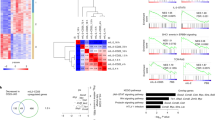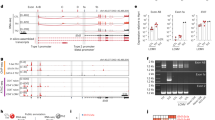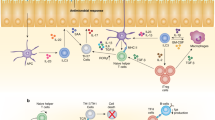Abstract
Interleukin 10 (IL-10) has a prominent function in regulating the balance between protective and pathological T cell responses. Consistent with that activity, many sources of this cytokine are found in vivo, including from myeloid cells and a variety of T cell subsets. However, although there are many pathways that regulate innate production of IL-10, the factors that govern its synthesis by the adaptive response are poorly understood. Here we report that IL-27 and IL-6 induced T helper type 1 and type 2 cells, as well as T helper cells that produce IL-17, to secrete IL-10. This effect was dependent on the transcription factors STAT1 and STAT3 for IL-27 and on STAT3 for IL-6. Our studies identify a previously unknown pathway that allows the immune system to temper inflammatory responses.
This is a preview of subscription content, access via your institution
Access options
Subscribe to this journal
Receive 12 print issues and online access
$209.00 per year
only $17.42 per issue
Buy this article
- Purchase on Springer Link
- Instant access to full article PDF
Prices may be subject to local taxes which are calculated during checkout







Similar content being viewed by others
References
Fiorentino, D.F., Bond, M.W. & Mosmann, T.R. Two types of mouse T helper cell. IV. Th2 clones secrete a factor that inhibits cytokine production by Th1 clones. J. Exp. Med. 170, 2081–2095 (1989).
Moore, K.W. et al. Homology of Cytokine synthesis inhibitory factor (IL-10) to the Epstein-Barr virus gene BCRFI. Science 248, 1230–1234 (1990).
Moore, K.W., de Waal Malefyt, R., Coffman, R.L. & O'Garra, A. Interleukin-10 and the interleukin-10 receptor. Annu. Rev. Immunol. 19, 683–765 (2001).
Kuhn, R., Lohler, J., Rennick, D., Rajewsky, K. & Muller, W. Interleukin-10-deficient mice develop chronic enterocolitis. Cell 75, 263–274 (1993).
Yen, D. et al. IL-23 is essential for T cell-mediated colitis and promotes inflammation via IL-17 and IL-6. J. Clin. Invest. 116, 1310–1316 (2006).
Grunig, G. et al. Interleukin-10 is a natural suppressor of cytokine production and inflammation in a murine model of allergic bronchopulmonary aspergillosis. J. Exp. Med. 185, 1089–1099 (1997).
Gazzinelli, R.T. et al. In the absence of endogenous IL-10, mice acutely infected with Toxoplasma gondii succumb to a lethal immune response dependent on CD4+ T cells and accompanied by overproduction of IL-12, IFN-γ and TNF-α. J. Immunol. 157, 798–805 (1996).
Hunter, C.A. et al. IL-10 is required to prevent immune hyperactivity during infection with Trypanosoma cruzi. J. Immunol. 158, 3311–3316 (1997).
Groux, H. et al. A CD4+ T-cell subset inhibits antigen-specific T-cell responses and prevents colitis. Nature 389, 737–742 (1997).
Suffia, I.J., Reckling, S.K., Piccirillo, C.A., Goldszmid, R.S. & Belkaid, Y. Infected site-restricted Foxp3+ natural regulatory T cells are specific for microbial antigens. J. Exp. Med. 203, 777–788 (2006).
Zhang, X. et al. IL-10 is involved in the suppression of experimental autoimmune encephalomyelitis by CD25+CD4+ regulatory T cells. Int. Immunol. 16, 249–256 (2004).
Jonuleit, H., Schmitt, E., Schuler, G., Knop, J. & Enk, A.H. Induction of interleukin 10-producing, nonproliferating CD4+ T cells with regulatory properties by repetitive stimulation with allogeneic immature human dendritic cells. J. Exp. Med. 192, 1213–1222 (2000).
Vieira, P.L. et al. IL-10-secreting regulatory T cells do not express Foxp3 but have comparable regulatory function to naturally occurring CD4+CD25+ regulatory T cells. J. Immunol. 172, 5986–5993 (2004).
Del Prete, G. et al. Human IL-10 is produced by both type 1 helper (Th1) and type 2 helper (Th2) T cell clones and inhibits their antigen-specific proliferation and cytokine production. J. Immunol. 150, 353–360 (1993).
Gerosa, F. et al. Interleukin-12 primes human CD4 and CD8 T cell clones for high production of both interferon-γ and interleukin-10. J. Exp. Med. 183, 2559–2569 (1996).
O'Garra, A. & Vieira, P. TH1 cells control themselves by producing interleukin-10. Nat. Rev. Immunol. 7, 425–428 (2007).
Trinchieri, G. Interleukin-10 production by effector T cells: Th1 cells show self control. J. Exp. Med. 204, 239–243 (2007).
Gerosa, F. et al. CD4+ T cell clones producing both interferon-γ and interleukin-10 predominate in bronchoalveolar lavages of active pulmonary tuberculosis patients. Clin. Immunol. 92, 224–234 (1999).
Pohl-Koppe, A., Balashov, K.E., Steere, A.C., Logigian, E.L. & Hafler, D.A. Identification of a T cell subset capable of both IFN-γ and IL-10 secretion in patients with chronic Borrelia burgdorferi infection. J. Immunol. 160, 1804–1810 (1998).
Anderson, C.F., Oukka, M., Kuchroo, V.J. & Sacks, D. CD4+CD25−Foxp3− Th1 cells are the source of IL-10-mediated immune suppression in chronic cutaneous leishmaniasis. J. Exp. Med. 204, 285–297 (2007).
Jankovic, D. et al. Conventional T-bet+Foxp3− Th1 cells are the major source of host-protective regulatory IL-10 during intracellular protozoan infection. J. Exp. Med. 204, 273–283 (2007).
Pflanz, S. et al. IL-27, a heterodimeric cytokine composed of EBI3 and p28 protein, induces proliferation of naive CD4+ T cells. Immunity 16, 779–790 (2002).
Chen, Q. et al. Development of Th1-type immune responses requires the type I cytokine receptor TCCR. Nature 407, 916–920 (2000).
Batten, M. et al. Interleukin 27 limits autoimmune encephalomyelitis by suppressing the development of interleukin 17-producing T cells. Nat. Immunol. 7, 929–936 (2006).
Amadi-Obi, A. et al. TH17 cells contribute to uveitis and scleritis and are expanded by IL-2 and inhibited by IL-27/STAT1. Nat. Med. 13, 711–718 (2007).
Kastelein, R.A., Hunter, C.A. & Cua, D.J. Discovery and biology of IL-23 and IL-27: related but functionally distinct regulators of inflammation. Annu. Rev. Immunol. 25, 221–242 (2007).
Villarino, A. et al. The IL-27R (WSX-1) is required to suppress T cell hyperactivity during infection. Immunity 19, 645–655 (2003).
Stumhofer, J.S. et al. Interleukin 27 negatively regulates the development of interleukin 17-producing T helper cells during chronic inflammation of the central nervous system. Nat. Immunol. 7, 937–945 (2006).
Villarino, A.V. et al. Positive and negative regulation of the IL-27 receptor during lymphoid cell activation. J. Immunol. 174, 7684–7691 (2005).
Chen, W. et al. Conversion of peripheral CD4+CD25− naive T cells to CD4+CD25+ regulatory T cells by TGF-β induction of transcription factor Foxp3. J. Exp. Med. 198, 1875–1886 (2003).
Rich, S., Seelig, M., Lee, H.M. & Lin, J. Transforming growth factor β1 costimulated growth and regulatory function of staphylococcal enterotoxin B-responsive CD8+ T cells. J. Immunol. 155, 609–618 (1995).
Fontenot, J.D. et al. Regulatory T cell lineage specification by the forkhead transcription factor foxp3. Immunity 22, 329–341 (2005).
Neufert, C. et al. IL-27 controls the development of inducible regulatory T cells and Th17 cells via differential effects on STAT1. Eur. J. Immunol. 37, 1809–1816 (2007).
Korn, T. et al. IL-21 initiates an alternative pathway to induce proinflammatory TH17 cells. Nature 448, 484–487 (2007).
Chiarle, R. et al. Stat3 is required for ALK-mediated lymphomagenesis and provides a possible therapeutic target. Nat. Med. 11, 623–629 (2005).
Barrat, F.J. et al. In vitro generation of interleukin 10-producing regulatory CD4+ T cells is induced by immunosuppressive drugs and inhibited by T helper type 1 (Th1)- and Th2-inducing cytokines. J. Exp. Med. 195, 603–616 (2002).
Hamano, S. et al. WSX-1 is required for resistance to Trypanosoma cruzi infection by regulation of proinflammatory cytokine production. Immunity 19, 657–667 (2003).
Rosas, L.E. et al. Interleukin-27R (WSX-1/T-cell cytokine receptor) gene-deficient mice display enhanced resistance to Leishmania donovani infection but develop severe liver immunopathology. Am. J. Pathol. 168, 158–169 (2006).
Wilson, E.H., Wille-Reece, U., Dzierszinski, F. & Hunter, C.A. A critical role for IL-10 in limiting inflammation during toxoplasmic encephalitis. J. Neuroimmunol. 165, 63–74 (2005).
Hunter, C.A. New IL-12-family members: IL-23 and IL-27, cytokines with divergent functions. Nat. Rev. Immunol. 5, 521–531 (2005).
Brightbill, H.D., Plevy, S.E., Modlin, R.L. & Smale, S.T. A prominent role for Sp1 during lipopolysaccharide-mediated induction of the IL-10 promoter in macrophages. J. Immunol. 164, 1940–1951 (2000).
Liu, Y.W., Chen, C.C., Tseng, H.P. & Chang, W.C. Lipopolysaccharide-induced transcriptional activation of interleukin-10 is mediated by MAPK- and NF-κB-induced CCAAT/enhancer-binding protein δ in mouse macrophages. Cell. Signal. 18, 1492–1500 (2006).
Lucas, M., Zhang, X., Prasanna, V. & Mosser, D.M. ERK activation following macrophage FcγR ligation leads to chromatin modifications at the IL-10 locus. J. Immunol. 175, 469–477 (2005).
Shoemaker, J., Saraiva, M. & O'Garra, A. GATA-3 directly remodels the IL-10 locus independently of IL-4 in CD4+ T cells. J. Immunol. 176, 3470–3479 (2006).
Lucas, S., Ghilardi, N., Li, J. & de Sauvage, F.J. IL-27 regulates IL-12 responsiveness of naive CD4+ T cells through Stat1-dependent and -independent mechanisms. Proc. Natl. Acad. Sci. USA 100, 15047–15052 (2003).
Ziegler-Heitbrock, L. et al. IFN-α induces the human IL-10 gene by recruiting both IFN regulatory factor 1 and Stat3. J. Immunol. 171, 285–290 (2003).
Hou, J. et al. An interleukin-4-induced transcription factor: IL-4. Stat. Sci. 265, 1701–1706 (1994).
Jacobson, N.G. et al. Interleukin 12 signaling in T helper type 1 (Th1) cells involves tyrosine phosphorylation of signal transducer and activator of transcription (Stat)3 and Stat4. J. Exp. Med. 181, 1755–1762 (1995).
Chen, Z. et al. Selective regulatory function of Socs3 in the formation of IL-17-secreting T cells. Proc. Natl. Acad. Sci. USA 103, 8137–8142 (2006).
Mathur, A.N. et al. Stat3 and Stat4 direct development of IL-17-secreting Th cells. J. Immunol. 178, 4901–4907 (2007).
Shull, M.M. et al. Targeted disruption of the mouse transforming growth factor-β1 gene results in multifocal inflammatory disease. Nature 359, 693–699 (1992).
Espevik, T. et al. Inhibition of cytokine production by cyclosporin A and transforming growth factor β. J. Exp. Med. 166, 571–576 (1987).
Silva, J.S., Twardzik, D.R. & Reed, S.G. Regulation of Trypanosoma cruzi infections in vitro and in vivo by transforming growth factor β (TGF-β). J. Exp. Med. 174, 539–545 (1991).
Hunter, C.A., Bermudez, L., Beernink, H., Waegell, W. & Remington, J.S. Transforming growth factor-β inhibits interleukin-12-induced production of interferon-γ by natural killer cells: a role for transforming growth factor-β in the regulation of T cell-independent resistance to Toxoplasma gondii. Eur. J. Immunol. 25, 994–1000 (1995).
Mosmann, T.R. & Coffman, R.L. TH1 and TH2 cells: different patterns of lymphokine secretion lead to different functional properties. Annu. Rev. Immunol. 7, 145–173 (1989).
Cohen, S.B. et al. High level of interleukin-10 production by the activated T cell population within the rheumatoid synovial membrane. Arthritis Rheum. 38, 946–952 (1995).
Bettelli, E. et al. Reciprocal developmental pathways for the generation of pathogenic effector TH17 and regulatory T cells. Nature 441, 235–238 (2006).
Lee, C.K. et al. STAT3 is a negative regulator of granulopoiesis but is not required for G-CSF-dependent differentiation. Immunity 17, 63–72 (2002).
Sharma, S.D., Mullenax, J., Araujo, F.G., Erlich, H.A. & Remington, J.S. Western blot analysis of the antigens of Toxoplasma gondii recognized by human IgM and IgG antibodies. J. Immunol. 131, 977–983 (1983).
Acknowledgements
WSX-1-deficient (Il27ra−/−) mice were provided by C. Saris (Amgen); BALB/c Il10−/− mice were originally obtained from R. Coffman (DNAX); Stat1−/− mice were provided by P. Scott (University of Pennsylvania); Foxp3GFP mice were provided by L. Turka (University of Pennsylvania); and CD4-Cre–Stat3−/− mice were provided by J.J. O′Shea (National Institutes of Health). Supported by the National Institutes of Health (AI42334 and AI41158 to C.H.; AI 43620 to L.T.; 1-T32-AI-055428 to J.S.S.; and 1-T32-AI-07532 to J.S.), the Scholler Foundation, the State of Pennsylvania, and the National Health and Medical Research Council of Australia.
Author information
Authors and Affiliations
Contributions
J.S.S. and C.A.H. contributed to all studies; J.S. and M.E. were involved in the analysis and interpretation of the p-STAT1 and p-STAT3 signaling experiments; T.H.H. was involved in the analysis of IL-10 expression by real-time quantitative PCR; A.L. and J.J.O. contributed to the studies of Stat3−/− CD4+ T cells; and P.M.P. and L.A.T. contributed to the studies of the Foxp3GFP mice.
Corresponding author
Ethics declarations
Competing interests
The authors have patents related to the use of IL-27.
Supplementary information
Supplementary Text and Figures
Supplementary Figures 1–4 and Table 1 (PDF 306 kb)
Rights and permissions
About this article
Cite this article
Stumhofer, J., Silver, J., Laurence, A. et al. Interleukins 27 and 6 induce STAT3-mediated T cell production of interleukin 10. Nat Immunol 8, 1363–1371 (2007). https://doi.org/10.1038/ni1537
Received:
Accepted:
Published:
Issue Date:
DOI: https://doi.org/10.1038/ni1537
This article is cited by
-
IL-27 gives a good gut feeling about immune regulation
Nature Immunology (2023)
-
Th17/IL-17 Axis in HTLV-1-Associated Myelopathy Tropical Spastic Paraparesis and Multiple Sclerosis: Novel Insights into the Immunity During HAMTSP
Molecular Neurobiology (2023)
-
Fungal sensing by dectin-1 directs the non-pathogenic polarization of TH17 cells through balanced type I IFN responses in human DCs
Nature Immunology (2022)
-
Dendritic cell-derived IL-27 p28 regulates T cell program in pathogenicity and alleviates acute graft-versus-host disease
Signal Transduction and Targeted Therapy (2022)
-
Anti-inflammatory cytokines in sickle cell disease
Molecular Biology Reports (2022)



